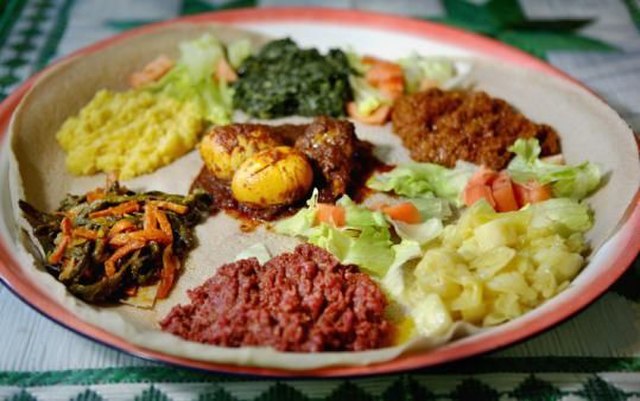On a table spread with woven baskets and clay dishes, Eritrea’s cuisine tells a story that is both intimate and expansive. Each meal carries echoes of the country’s diverse ethnic groups, its Red Sea coastline, and the neighboring cultures that have shaped its traditions over centuries. The result is a distinctive culinary identity—layered with history, yet alive in the daily rituals of communal dining.
At the center of almost every meal is injera, the spongy, slightly tangy flatbread made from teff, a resilient grain native to the Horn of Africa. Its broad surface doubles as both plate and utensil, serving as the foundation for stews and salads. Tearing pieces of injera by hand and sharing from the same platter remains a central gesture of Eritrean hospitality, a custom that binds family and friends together around the table.
Few dishes capture Eritrea’s use of spice more vividly than zighni. Prepared with beef or chicken, the stew simmers slowly in a sauce built on berbere, the fiery blend of chili, garlic, ginger, and aromatics that is fundamental to the region’s cooking. The result is a dish of depth and intensity, each bite a reminder of the country’s devotion to bold flavors.
Equally emblematic is shiro, a smooth, fragrant stew of ground chickpeas or lentils. It is especially common during fasting periods observed by many Eritreans, reflecting the intersection of religious practice and cuisine. Vegetarian yet deeply satisfying, shiro is among the dishes that demonstrate the adaptability of Eritrean cooking to varied diets and traditions.
Along the Red Sea coast, seafood provides a natural abundance. Fish stews—sometimes variations of zighni—feature the day’s catch, seasoned with herbs and spices that enhance rather than overshadow the freshness of the sea. The maritime influence adds a distinctive dimension to the national menu, linking the land’s traditions with the resources of its waters.
Another preparation, kitfo, presents a sharper contrast. This dish of minced raw beef, delicately seasoned and occasionally served lightly seared, is accompanied by spiced butter and fresh greens. Its preparation and presentation highlight the balance between richness and restraint, a quality found across much of Eritrean cooking.
No culinary portrait of Eritrea would be complete without coffee. The traditional ceremony, conducted with green beans roasted in view of guests and brewed in a clay jebena, extends beyond the drink itself. It is a social ritual—slow, deliberate, and communal—where conversation and connection are as essential as the brew.
Eritrean cuisine, in its breadth and detail, is more than sustenance. It is an expression of cultural memory and daily life, shaped by geography, faith, and history. To share in it is to glimpse a society where meals are not solitary acts, but collective experiences rooted in tradition and carried forward through generations.
Sources:
- David Turton, Cultural Foods of the Horn of Africa, Journal of African Studies, 2019.
- Tekeste Negash, Eritrea: The Cultural Landscape, Nordiska Afrikainstitutet, 2011.
- Fran Osseo-Asare, Food Culture in Sub-Saharan Africa, Greenwood Press, 2005.
- Interviews with Eritrean chefs featured in BBC Travel and The Guardian, 2020–2022.

